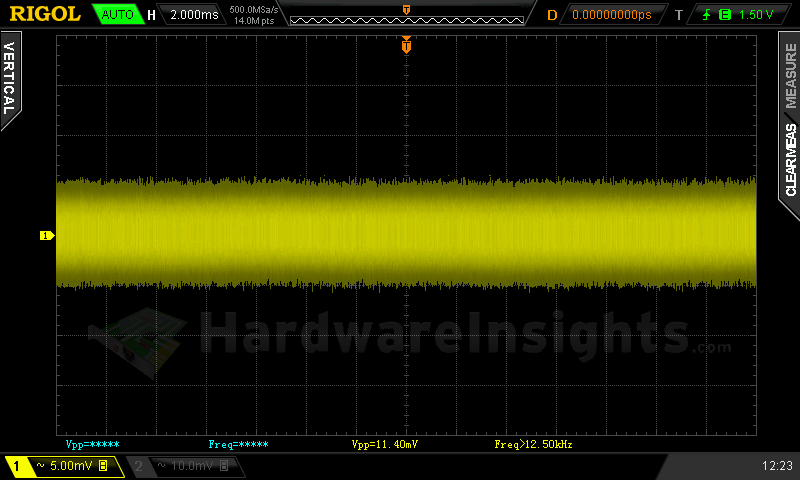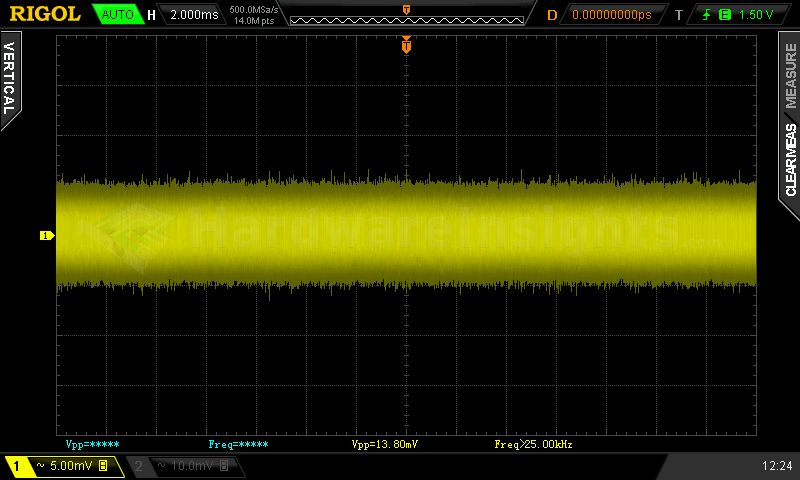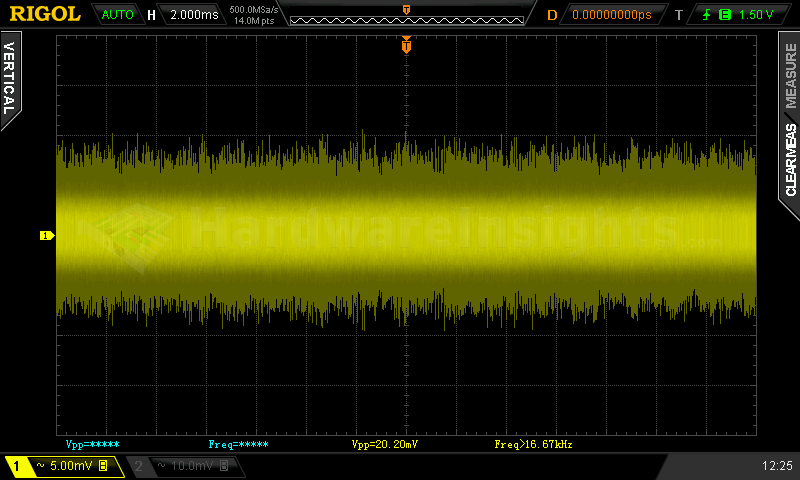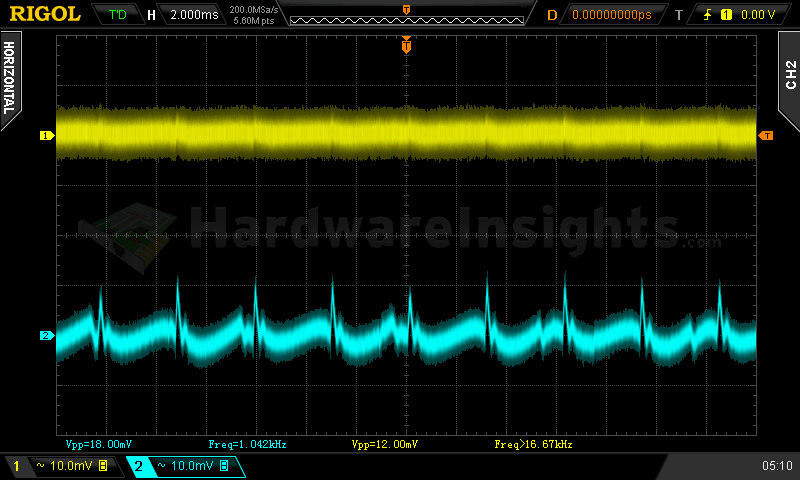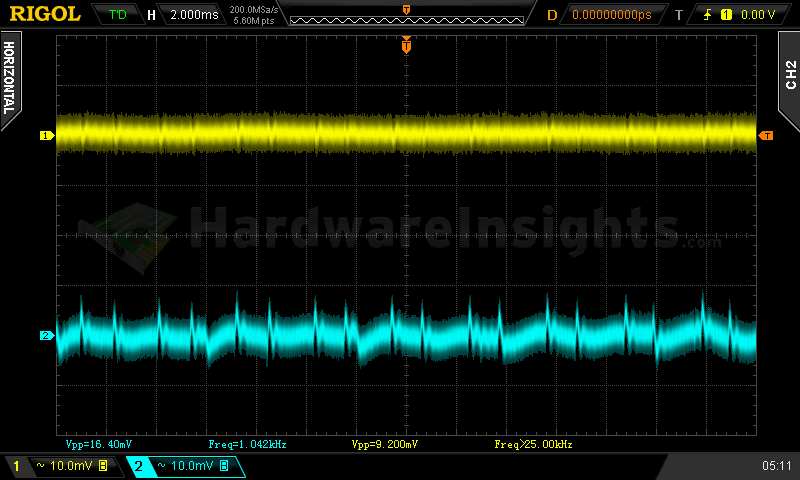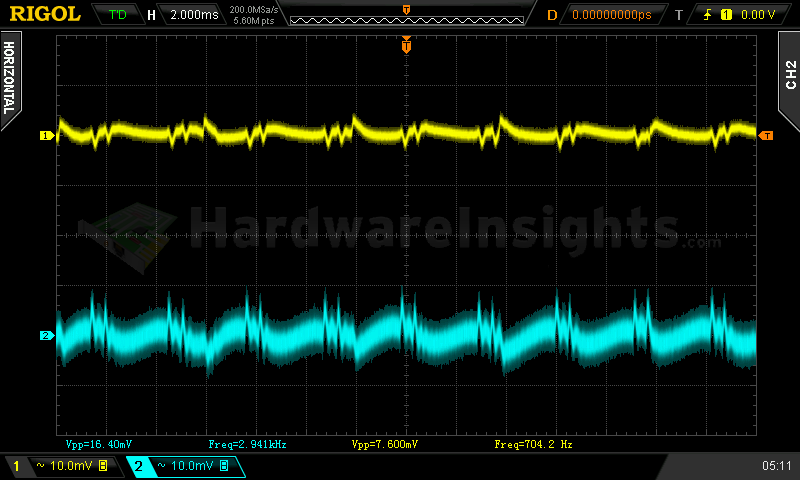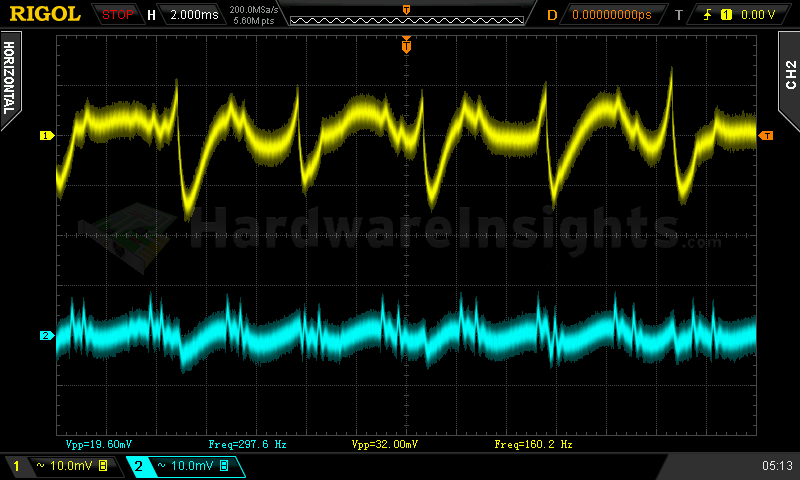Contents
- 1Introducing the Linkworld Stability Power LPJ9-25 420 W
- 1.1Packaging and accessories
- 2Connectors & cabling
- 2.1Casing & cooling
- 3Input filtering
- 4Primary side
- 4.1+5 V stand-by rail
- 5Secondary side
- 5.1Build quality
- 6Load testing
- 6.1Loading +5 V SB
- 6.2Hold-up time
- 6.3Combined loading
- 6.4Combined loading ripple
- 6.5Crossloading, overloading
- 6.6Crossloading, overloading ripple
- 6.7Fan speed, temperatures and noise
- 7Conclusion and evaluation
- 7.1Thanks
- 7.2Discussion
Load testing
Loading +5 V SB
As always, all load testing is done according to our testing methodology. The voltage regulation and ripple suppression is OK. Thanks to the SanKen microchip this unit actually keeps low idle consumption so also the efficiency is reasonable. Nothing great, but yeah, this is OK for low-end.
| Output (W) | Load (A) | Voltage (V)/ ripple (mV) | Input (W) | Efficiency/power factor |
| 0 | 0 | 5.14/11.40 | 0.08 | —/0.048 |
| 9.53 | 1.91 | 5.00/13.80 | 13.60 | 70.0 %/0.533 |
| 14.88 | 3.18 | 4.68/20.20 | 21.35 | 69.7 %/0.615 |
+5 V SB ripple (left to right): 0 A; 1.91 A; 3.18 A
Hold-up time
There is no hold-up time measurement as the unit failed to provide nominal power output.
Combined loading
Combined loading of the LPJ9-25 was a disaster. The unit provided only about 200 W in spec, then the voltage at +3.3 and +5 V plummeted. The maximum I got from this unit was less than 300 W. Increasing the load any more dropped the voltage at +3.3 V once again, which resulted in lower output. The voltage then also decreased under 3 V. Most likely there is no OPP and just the undervoltage protection kicked in. The regulation is complete garbage, the unit did not care at all what voltages it has on different rails with certain combinations of load. You cannot even tell this unit is +3.3 or +5 V heavy as with certain configurations even voltages on these rails were completely out of the nominal. The power distribution table is then just a joke, I tried to apply load according to it and just look at the voltages at the final measurement. Previous El Cheapo units were no wonders but they usually kept reasonable regulation until they shut down (sometimes for good). This is just horrible.
| Output power | Load/ voltage +5 V SB | Load/ voltage +3.3 V | Load/ voltage +5 V | Load/ voltage +12 V | Load/ voltage −12 V | Input power | Efficiency/ power factor |
| 6.5 %/ 27.18 W | 0 A/ 5.13 V | 0 A/ 3.44 V | 0.382 A/ 5.18 V | 1.796 A/ 11.93 V | 0.358 A/ −10.89 V | 42.08 W | 64.6 %/ 0.724 |
| 20 %/ 81.64 W | 0.537 A/ 5.06 V | 1.500 A/ 3.38 V | 4.88 A/ 5.02 V | 3.29 A/ 12.15 V | 0.382 A/ −11.39 V | 110.0 W | 74.2 %/ 0.769 |
| 40 %/ 165.59 W | 0.986 A/ 5.01 V | 7.01 A/ 3.31 V | 11.57 A/ 4.97 V | 5.54 A/ 12.16 V | 0.382 A/ −11.89 V | 229.9 W | 72.0 %/ 0.770 |
| 60 %/ 243.39 W | 1.53 A/ 4.90 V | 13.00 A/ 3.03 V | 17.54 A/ 4.69 V | 8.98 A/ 12.17 V | 0.399 A/ −12.42 V | 366.1 W | 66.5 %/ 0.745 |
|
70 %/ 295.49 W |
1.75 A/ 4.87 V | 10.20 A/ 3.24 V | 21.48 A/ 3.08 V | 14.28 A/ 12.96 V | 0.211 A/ −12.87 V | 505.5 W | 58.5 %/ 0.755 |
The efficiency also dropped significantly from already very low values starting with approx. 60% load. The reason is especially the PFC coil which is very undersized for this unit. Later it ran incredibly hot and was creating the worst smell I encountered so far. Judging how hot it was after ten minutes of idling and disassembling the unit (to prepare fan for noise measurement), I think it could have been easily hitting anything between 120 and 150 °C. If somebody pushed this unit for longer time the coil would most likely eventually melt (at least the wire lacquering will do for sure). As it uses iron core which will not lose its magnetic properties at such “low” temperatures as the ferrite cores do so it will just continue heating up. Hopefully without fire, then it would lose its filtering abilities and the power factor would drop further to 0.5-0.6 level.
Combined loading ripple
Ripple on the other hand was within spec, which is especially strange when none of the rails have full filter and the +12 V actually only has single capacitor.
| Output % | Ripple +5 V SB | Ripple +3.3 V | Ripple +5 V | Ripple +12 V | Ripple −12 V |
| 6.5 | 6.800 mV | 5.200 mV | 16.00 mV | 32.80 mV | 26.00 mV |
| 20 | 9.200 mV | 9.600 mV | 8.800 mV | 20.00 mV | 28.00 mV |
| 40 | 5.200 mV | 11.20 mV | 9.200 mV | 17.20 mV | 25.60 mV |
| 60 | 8.800 mV | 13.60 mV | 13.60 mV | 22.80 mV | 29.60 mV |
| 70 | 12.80 mV | 8.000 mV | 15.60 mV | 19.60 mV | 42.40 mV |
Ripple 6.5% load (left to right): +5 V SB; +3.3 V; +5 V; −12 V. The second channel is connected to +12 V.
Crossloading, overloading
As could already be expected from the combined loading, crossloading was even worse. Judging by the fact the voltage at +3.3 V rail dropped all the way down to 2.26 V and it was still kicking, I would say the LPJ9-25 actually seems to have some kind of OPP in the end. But it can just dream about UVP. And look at the efficiency. I can’t even look at this, lets move on.
| Output power | Load/ voltage +5 V SB | Load/ voltage +3.3 V | Load/ voltage +5 V | Load/ voltage +12 V | Load/ voltage −12 V | Input power | Efficiency/ power factor |
| 17 %/ 92.90 W | 0.531 A/ 5.04 V | 15.45 A/ 2.26 V | 1.527 A/ 5.05 V | 1.826 A/ 11.83 V | 0.370 A/ −11.05 V | 121.8 W | 58.3 %/ 0.779 |
| 37 %/ 150.04 W | 0.520 A/ 5.01 V | 1.366 A/ 3.32 V | 25.9 A/ 4.54 V | 1.922 A/ 12.78 V | 0.371 A/ −12.15 V | 231.3 W | 66.5 %/ 0.776 |
| 49 %/ 167,59 W | 0.529 A/ 5.03 V | 1.414 A/ 3.35 V | 1.620 A/ 5.22 V | 16.96 A/ 11.03 V | 0.394 A/ −11.56 V | 295.3 W | 70.3 %/ 0.756 |
Crossloading, overloading ripple
Though at some tests the ripple increased noticeably, it was – surprisingly – still within spec.
| Output % | Ripple +5 V SB | Ripple +3.3 V | Ripple +5 V | Ripple +12 V | Ripple −12 V |
| 17 | 12.00 mV | 30.80 mV | 16.80 mV | 31.20 mV | 30.40 mV |
| 37 | 11.60 mV | 5.200 mV | 14.80 mV | 20.40 mV | 31.20 mV |
| 49 | 12.00 mV | 8.400 mV | 17.20 mV | 24.80 mV | 31.60 mV |
Fan speed, temperatures and noise
The fan inside the Linkworld LPJ9-25 started spinning right when the unit powered on. By the fourth test it was already running at full speed, yet despite that the temperatures were extreme. Especially because of the PFC coil which was trying to melt itself. It was still reasonably quiet at test three, with higher speed it got noisier. As the fan is small the high speed does not make it run so loud as some 120mm fans at around 2000 RPM.
| Output % | Fan speed (RPM) | Temperature intake/ outtake | Noise (dBA) |
| 6.5 | 868 | 27 °C/ 29 °C | 39.5 |
| 20 | 1113 | 27 °C/ 34 °C | 39.5 |
| 40 | 1451 | 27 °C/ 40 °C | 39.6 |
| 60 | 2445 | 29 °C/ 48 °C | 42.2 |
| 70 | 2532 | 30 °C/ 57 °C | 42.7 |
| CL 17 | 1325 | 28 °C/ 46 °C | 39.6 |
| CL 37 | 2324 | 29 °C/ 44 °C | 41.5 |
| CL 49 | 2128 | 30 °C/ 45 °C | 40.7 |
But I don’t think the noise matters, would anybody other than government buy this thing willingly? Thinking about this fact and the regulations instigated upon market as a result (which would not be necessary if government agencies and bureaus would not be the greatest current customer for these craps; nobody sane buys these units in retail anymore) makes me just mad so let’s move on.
